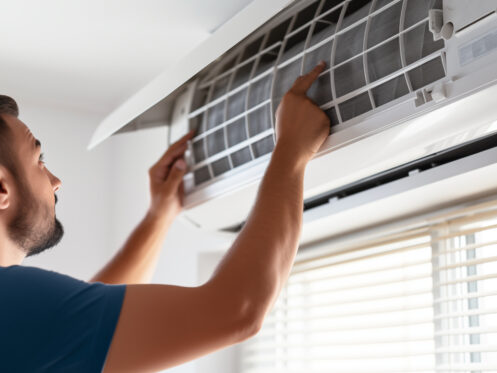If you’re considering a ductless mini-split for your Lincoln, NE home, your first task is determining which size to buy. For best results, you should let the experts from John Henry's Plumbing, Heating, Air, and Electrical figure that out for you. However, that doesn’t mean you shouldn’t know what goes into the HVAC sizing equation. Using that information, you can figure out a reasonable size estimate to aid you in your system research. With that in mind, here’s a complete guide to choosing the right size mini-split.
Basic Mini-Split Size Estimation Method
If all you need is an approximate system size, there’s a simple formula you can use. You must start by calculating the total square footage you need your mini-split to heat and cool. To do that, multiply the length and width of each room and add all the results. Then multiply your result by 25 BTUs. That’s the average capacity required for each square foot. The result will tell you the total BTU output needed for any mini-split you purchase.
Unfortunately, some mini-splits don’t use BTUs as their primary capacity measure. Some use tons to denote their capacity, much like conventional HVACs. You only need to know that one ton equals 12,000 BTUs to convert between the two. So, if you divide your estimate by 12,000, you’ll find out the required system size in tons. However, be aware that AC systems only come in half-ton increments. So, when you arrive at an uneven number, you must round up to the next half-ton.
Considering Mini-Split Zone Size
While the above formula will tell you the total capacity you need from a prospective mini-split, there’s more to consider. You must also know that a mini-split can only support up to eight air handlers. And, assuming your home’s rooms are not uniformly sized, that adds some complexity. It means you must choose a combination of air handlers, each with different capacities, that don’t exceed your system’s total BTU capacity. Standard mini-split air handlers tend to come in the following capacities:
- 6,000 BTUs – Up to 240 square feet
- 9,000 BTUs – Up to 360 square feet
- 12,000 BTUs – Up to 480 square feet
- 15,000 BTUs – Up to 600 square feet
- 18,000 BTUs – Up to 720 square feet
You should always round up to the closest available capacity when choosing your air handler sizes. You may find that doing so could force you to increase your total mini-split capacity to account for available air handler capacities. If so, it may increase your system’s cost, but choosing too small a system may leave your home uncomfortable. So, buying a slightly oversized system is always better than an undersized one.
If you own a particularly large home, installing multiple mini-splits to cover it all may be necessary. The good news is that installing multiple mini-splits may make your installation easier. Since each air handler connects to the outdoor unit via refrigerant and power lines, there are distance restrictions. If you’re installing multiple mini-splits, that’s less of a problem. You can, for example, install one to serve one side of your home and leave the rest to your second unit.
Other Mini-Split Size Considerations
Following the guidance above will only yield a ballpark-estimated system size. For a more precise sizing, there are more factors you must consider. They include the following.
Ceiling Heights
One thing to consider is the height of the ceilings in your home. The 25 BTU per square foot figure in the above formula assumes you have standard eight-foot ceilings. If your home has rooms with ceilings higher than that, it will affect their heating and cooling needs. Generally, you should add 12.5% to your BTU room estimates for every extra foot of ceiling height. That will help ensure you don’t undersize the air handler in that space.
Your Home’s Insulation
It should go without saying, but the quality of your home’s insulation also plays a role in your required mini-split size. Once again, the 25 BTU per square foot figure assumes you live in a relatively new house with decent insulation. If you live in an older home that’s not well-insulated, you may need to increase your capacity estimate by up to 20%. In many cases, it’s wise to have your home professionally air-sealed and its insulation upgraded before a mini-split installation. It can save you substantial sums on both your mini-split’s cost and your heating and cooling costs in the future.
Windows and Solar Exposure
Another thing to consider is the number of windows in your rooms and how much sun they get. So, if you have a room with multiple windows that gets plentiful sun, increase that room’s BTU requirements by 10%. If your windows are old and don’t have double or triple-pane glass, you may need an additional 10%. Conversely, if you have a room with few windows and ample shade, decrease its BTU estimate by 10%.
Room Usage Considerations
Certain room uses may affect the HVAC capacity that a given room needs. For example, if you plan to install a mini-split air handler in a kitchen, it will need some extra power. As a rule of thumb, you should add 4,000 BTUs to your kitchen’s estimate. The same goes for any other spaces with large, heat-producing appliances.
Occupancy
Finally, one of the best things about ductless mini-splits is that they offer zoned heating and cooling. That means you can set different temperatures in different spaces. It also lets you turn off individual air handlers in disused spaces to save money. However, it also means considering room occupancy in your sizing calculations.
Remember, humans generate significant amounts of heat. Even sitting still, a human body will add about 500 BTUs of heat to a room per hour. That number only rises with physical activity. As a result, you will want added cooling capacity in your most-used spaces. You should add 600 BTUs of capacity to each room per person to ensure you have it. So, if you’re in a four-person household, you may need an extra 2,400 BTUs in your living room. You may also need an additional 1,200 BTUs in your master bedroom.
Your Trusted Local Mini-Split Experts
The bottom line is that selecting the proper size mini-split for your home isn’t a job for an amateur. It’s such a complex process that HVAC technicians use an entire guidebook called Manual J to get it right. The HVAC experts here at John Henry's Plumbing, Heating, Air, and Electrical can perform an exact Manual J calculation for your home. That’s how we can ensure you get the ductless mini-split that best meets your needs.
We’re a locally owned HVAC company that’s served Lincoln homeowners since 1996. Also, we sell and install the latest ACs and mini-splits from industry leader Lennox. We can even provide financing options on approved credit to help you pay for the new mini-split you want. So, if you want a new ductless mini-split for your Lincoln home, call our team at John Henry's Plumbing, Heating, Air, and Electrical today!

